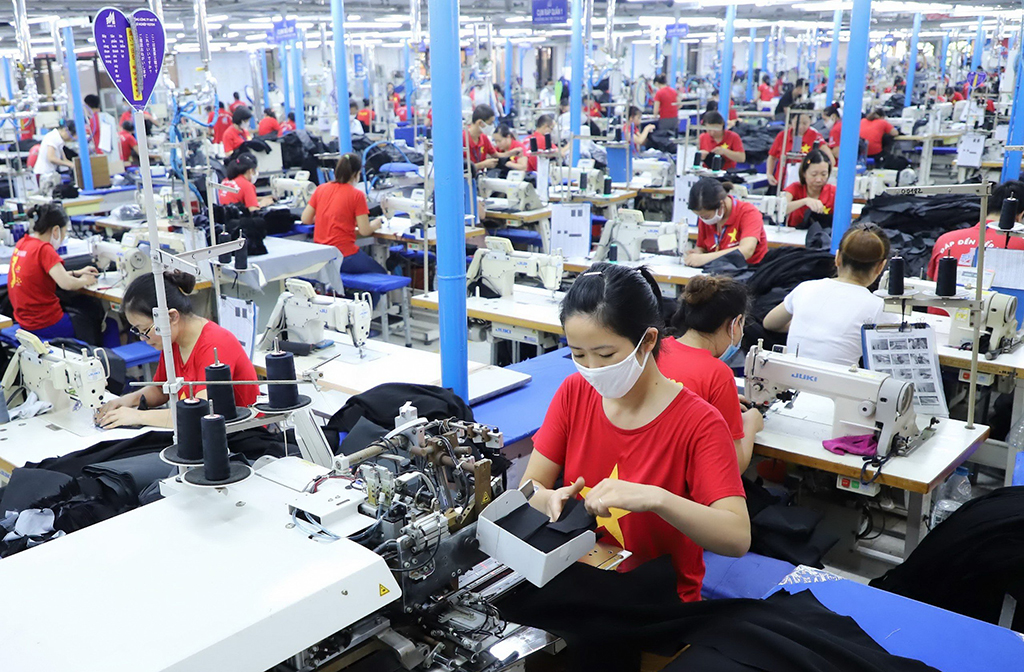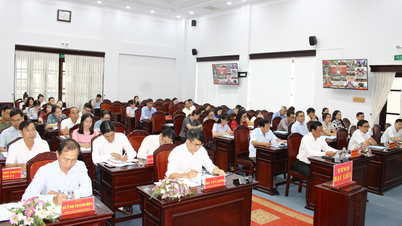Production from small to large reduces labor
Ms. TTSuong is the owner of a small garment factory specializing in middle-aged fashion in Ward 15, Tan Binh District (HCMC) and has had 2 wholesale clothing stalls at Tan Binh Market for nearly 20 years. After 2 years of the pandemic outbreak, business in the market almost froze. At the end of 2022, she was forced to close 2 stalls at Tan Binh Market and return to An Dong Market (District 5) to rent 2 stalls to continue her business.
Ms. Suong confided: "No longer waiting for customers to come to the market to buy goods, we have to find other ways to "feed" more than 20 workers who are persistently sticking with their families. However, by last August, the remaining veteran workers had "fallen away", now only half remain. These workers are attached to the facility and are like children in the family, they are old, now they have returned to their hometowns and don't know what to do, so the facility is trying to hold on so that the owner and the workers can have food together. The workers' income is from 9 - 11 million VND, now the sewing industry has decreased sharply, the end-of-month salary is 6 - 7 million VND, they still "rely" on each other and live. By the end of this year, if the business at An Dong does not develop, we can return these two stalls."

The textile industry is trying to overcome the current difficult period.
Similarly, the D&T garment factory (District 8, Ho Chi Minh City) said that its family-owned garment factory, which had more than 100 workers, now has 65 people and the family is trying to maintain jobs to "feed" these workers. Ms. Thai Van, the manager of the garment factory, shared: "We are luckier because we make self-designed products and sell them to the domestic market, so even though domestic consumers reduce their spending on shopping, try to expand and find customers, we can still continue to operate. Currently, there are too many small garment factories specializing in processing goods for large export companies that are forced to close down and stop operating. Before it was difficult to recruit workers, now almost every day there are people with 5-10 years of experience applying to do sewing, ironing, and folding. Even people with experience in cutting and packaging - a field that was previously very difficult to find workers - also come to apply for jobs."
Not only small production facilities, the situation of cutting workers in large numbers also continues to occur in many enterprises. Recently, the news that the "giant" Garmex Saigon textile and garment industry has gone from 4,000 workers to only 35 people has made many people sad and surprised. Because Garmex Saigon is a reputable enterprise with many years of experience in the industry, a partner supplying fashion products to many major fashion brands in the world. In 2021, the company also had 233 billion VND in undistributed profits. However, the post-Covid-19 storm has reversed the situation, the company's export orders decreased, causing export sales to decrease by... 93% in 2022. After nearly 20 years, for the first time, the company recorded a loss of more than 80 billion VND at the end of last year. Information updated to the end of September, the inventory related to processing is estimated at up to 100 billion VND.
Not only in the manufacturing industry, the wave of large-scale layoffs continues to occur in many service businesses. Mobile World Investment Corporation, in the period from September 2022 to May 2023, has cut more than 12,000 employees. Or in the real estate sector, many businesses said they cut 30-70% of their staff because... there is nothing for employees to do or the business is forced to downsize or temporarily suspend operations.
Quick view at 12:00 on November 4: Panorama news
The wave of layoffs is not over yet?
In a recent report on Vietnam's human resource trends in the first half of 2023 by Anphabe, a consulting company on employer branding solutions and happy working environments, it was shown that within 9 months from September 2022 to May 2023, an average of 3/10 businesses were forced to cut human resources at various scales. The survey showed that about 13% of employees in Vietnam have been and are being directly affected by layoffs, concentrated more at the employee level and especially the group still in the probationary period. Notably, Anphabe predicts that the "wave of layoffs" will continue in the coming time. At the management level, by the middle of this year, in addition to 33% of businesses that have made cuts, 13% of businesses said through the survey that they will continue to cut in the coming time; 34% decided to keep the same and only 20% have plans to increase human resources.
Mr. Pham Xuan Hong, Chairman of the Ho Chi Minh City Textile, Garment, Embroidery and Knitting Association, said that enterprises operating in the textile, garment and footwear industries, major export industries of Ho Chi Minh City, are still facing many difficulties, although compared to the beginning of the year, orders have "started" to increase again. About 30% of enterprises are seriously lacking orders, and financial resources to expand production and wait for new orders have also dried up, so the recovery of production in some places is a good sign but not yet a worry-free one.
Mr. Nguyen Quoc Hung, director of a company specializing in the production and trading of plant protection chemicals in Dong Nai, said that the case of cutting down on labor is a "must-have" both in terms of situation and procedure when the company has to carry out a series of procedures for unemployment benefits which are very complicated and... costly. However, cutting down on personnel to move towards a streamlined production and business operation apparatus, optimizing all stages as a form of restructuring management and operation after the crisis is also the form that the company is aiming for.
There is an important shift
While Ho Chi Minh City in particular and the southern region in general are still facing increasing layoffs, in October, the whole country had more than 15,400 newly established enterprises with a total registered capital of VND125,800 billion, the number of registered employees increased to nearly 131,600 employees, an increase of 21.7% in the number of enterprises, an increase of 7.4% in registered capital and an increase of 64.3% in the number of employees compared to September. Compared to the same period last year, the number of newly registered enterprises increased by 18.5% and the number of registered employees also increased by more than 71%. In the whole 10 months of this year, the whole country had 131,800 newly registered enterprises, an increase of 4.7%; the number of employees was 880,000 people, an increase of 5.4%. However, the average capital of a newly registered enterprise in October decreased by 11.7% and in 10 months also decreased by more than 16% compared to the same period in 2022.
Economist, Associate Professor, Dr. Nguyen Thuong Lang (Institute of International Trade and Economics, National Economics University) commented that the increase in the number of new enterprises and the number of enterprises returning to the market shows an optimistic economic outlook at the end of the year. The layoffs of workers may be due to the impact of economic restructuring, restructuring enterprises towards reducing the number of workers, increasing investment in using technological advances, and optimizing lean business models. This is a good sign that the re-assignment of labor between industries and regions has been taking place. "According to our observations and research, the demand for highly skilled labor is increasing and the demand for unskilled labor is decreasing much more. Thus, there has been an important shift in the labor market," said Mr. Lang, adding that in the long term, this trend of economic restructuring is completely appropriate.
"The adjustment of the labor structure will create conditions for adjusting the labor market according to the nature of the market economy. Many unskilled workers are being laid off and losing their jobs, affecting people's lives. However, skilled workers in high-tech and professional service industries, which large cities like Ho Chi Minh City are leading, will develop more strongly. Therefore, Ho Chi Minh City's position as an economic locomotive is under more pressure, but it will not change because of that shift. Moreover, this is also a signal affirming Ho Chi Minh City's position as a locomotive in the new period. And it is an optimistic signal showing economic adjustment and maintaining growth momentum for the last months of the year," Mr. Lang analyzed.
Exports have fallen sharply as global purchasing power in the fashion sector in general has fallen by more than 25% this year. Many businesses have been forced to change their business direction, but changing to make one product at this time is not simple. Therefore, this year is still a difficult year for many manufacturing businesses in general.
Mr. Pham Xuan Hong , Chairman of Ho Chi Minh City Textile, Embroidery and Knitting Association
Source link

































![[Photo] Prime Minister Pham Minh Chinh works with the Standing Committee of Thai Binh Provincial Party Committee](https://vphoto.vietnam.vn/thumb/1200x675/vietnam/resource/IMAGE/2025/5/12/f514ab990c544e05a446f77bba59c7d1)
![[Photo] Prime Minister Pham Minh Chinh receives Swedish Minister of International Development Cooperation and Foreign Trade](https://vphoto.vietnam.vn/thumb/1200x675/vietnam/resource/IMAGE/2025/5/12/ae50d0bb57584fd1bbe1cd77d9ad6d97)

































































Comment (0)